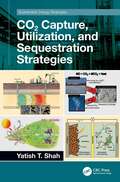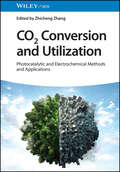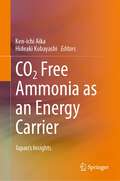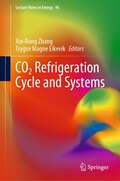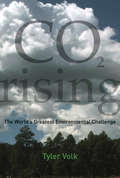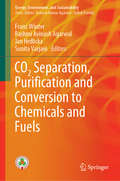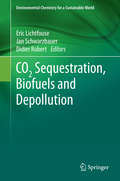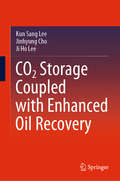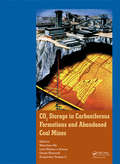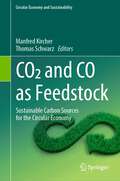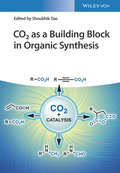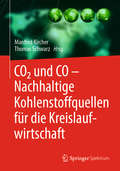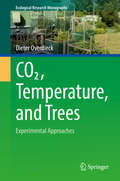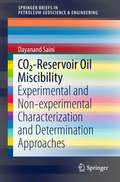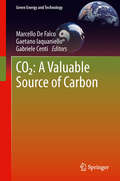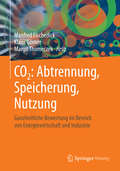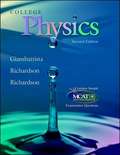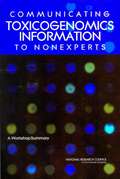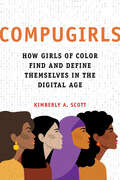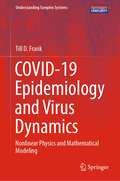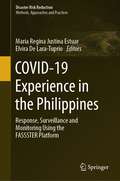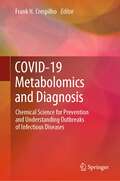- Table View
- List View
CO2 Capture, Utilization, and Sequestration Strategies (Sustainable Energy Strategies)
by Yatish T. ShahOffering practical treatment strategies for CO2 emission generated from various energy-related sources, CO2 Capture, Utilization, and Sequestration Strategies emphasizes carbon capture, utilization, and sequestration (CCUS) with special focus on methods for each component of the strategy. While other books mostly focus on CCS strategy for CO2, this book details the technologies available for utilization of CO2, showing how it can be a valuable renewable source for chemicals, materials, fuels, and power instead of a waste material damaging the environment. Highlights current and potential future commercially viable CCUS strategies Discusses applications for direct and the more complex indirect utilization of CO2 streams Examines viability of the mineral carbonation process and biological treatments to convert CO2 into useful biochemicals, biomaterials, and biofuels Explores heterogeneous catalysis for thermal and electrochemical conversion and solar energy-based thermal, photo-thermal, and photocatalytic conversion of CO2 Presents the rapidly growing concept of plasma-activated catalysis for CO2 conversion CO2 Capture, Utilization, and Sequestration Strategies is a valuable reference for researchers in academia, industry, and government organizations seeking a guide to effective CCUS processes, technologies, and applications.
CO2 Conversion and Utilization: Photocatalytic and Electrochemical Methods and Applications
by Zhicheng ZhangCO2 Conversion and Utilization Comprehensive overview of current development of various catalysts in CO2 conversion and utilization through photocatalytic and electrochemical methods CO2 Conversion and Utilization systematically summarizes the development of CO2 photo- and electro-conversion and utilization, especially the reaction mechanism, engineering and technology of testing, and preparation methods and physicochemical properties of various catalytic materials. The rational design and preparation of catalysts, development of characterization technologies, and in-depth understanding of catalytic mechanisms are systematically discussed. In particular, the various parameters influencing the photocatalytic and electrochemical CO2 reduction are emphasized. The underlying challenges and perspectives for the future development of efficient catalysts for CO2 reduction to specific chemicals and fuels are discussed at the end of the text. Written by a highly qualified author with significant experience in the field, CO2 Conversion and Utilization includes information on: Measurement systems and parameters for CO2 photo/electro-conversion, CO2 photo/electro-conversion mechanism, and Cu-based and Cu-free metal materials for electrocatalytic CO2 reduction Organic-inorganic, metal organic framework, and covalent organic framework hybrid materials for CO2 photo/electro-conversion Single/dual-atom catalysts, homogeneous catalysts, and high-entropy alloys for CO2 photo/electro-conversion Semiconductor composite and carbon-based materials for photocatalytic CO2 reduction, novel routes for CO2 utilization via metal-CO2 batteries, and CO2 conversion into long-chain compounds Providing comprehensive coverage of the subject, CO2 Conversion and Utilization is of high interest for scientific researchers as well as engineers and technicians in industry, including but not limited to photochemists, electrochemists, environmental chemists, catalytic chemists, chemists in industry, and inorganic chemists.
CO2 Free Ammonia as an Energy Carrier: Japan's Insights
by Ken-Ichi Aika Hideaki KobayashiThis book describes important findings in intensive studies conducted in Japan on ammonia as an energy carrier. It illustrates an advanced solar-heat capture system and storage materials at 600°C and hydrogen production with SOECs and a new IS method through the use of heat. New industrial ammonia catalysts and a demonstration process that started running in Fukushima are also introduced. Advanced ammonia decomposition catalysts and the process that were developed for use by the hydrogen station are presented. An advanced direct ammonia fuel cell was developed and the base data are shown. The book explains that ammonia is used as a fuel for industrial applications because its burning can be controlled without emitting extra NOx in the gas turbine and the real coal co-fired power plant. These breakthroughs have made a strong impact in the world as a practical technology for CO2 reduction. Also provided here are the scientific and industrial backgrounds as well as the environmental assessment and economic evaluation for the future.This book will be helpful for all who are interested in energy technology—researchers, students, and strategy planners at companies and in the government.
CO2 Refrigeration Cycle and Systems (Lecture Notes in Energy #96)
by Xin-Rong Zhang Trygve Magne EikevikThis book covers the fundamentals and applications of carbon dioxide vapor compression refrigeration thermodynamic cycles. In particular, it presents new application areas, such as making ice and snow in the Winter Olympic Games, food cooling and refrigeration. The book explores the physical and chemical characteristics of CO2 fluid, and the unique traits of its thermodynamic cycle. The contributors explain how CO2 refrigeration is a developing, eco-friendly technology, and emphasize its importance for refrigeration and air-conditioning in the current and future market.This book is a valuable source of information for researchers, engineers and policy makers looking to expand their applicable knowledge of high-potential refrigeration technology using carbon dioxide. It is also of interest to postgraduate students and practitioners looking for an academic insight into the industry’s latest eco-friendly technologies.
CO2 Rising: The World's Greatest Environmental Challenge (The\mit Press Ser.)
by Tyler VolkAn introduction to the global carbon cycle and the human-caused disturbances to it that are at the heart of global warming and climate change.The most colossal environmental disturbance in human history is under way. Ever-rising levels of the potent greenhouse gas carbon dioxide (CO2) are altering the cycles of matter and life and interfering with the Earth's natural cooling process. Melting Arctic ice and mountain glaciers are just the first relatively mild symptoms of what will result from this disruption of the planetary energy balance. In CO2 Rising, scientist Tyler Volk explains the process at the heart of global warming and climate change: the global carbon cycle. Vividly and concisely, Volk describes what happens when CO2 is released by the combustion of fossil fuels (coal, oil, and natural gas), letting loose carbon atoms once trapped deep underground into the interwoven web of air, water, and soil. To demonstrate how the carbon cycle works, Volk traces the paths that carbon atoms take during their global circuits. Showing us the carbon cycle from a carbon atom's viewpoint, he follows one carbon atom into a leaf of barley and then into an alcohol molecule in a glass of beer, through the human bloodstream, and then back into the air. He also compares the fluxes of carbon brought into the biosphere naturally against those created by the combustion of fossil fuels and explains why the latter are responsible for rising temperatures. Knowledge about the global carbon cycle and the huge disturbances that human activity produces in it will equip us to consider the hard questions that Volk raises in the second half of CO2 Rising: projections of future levels of CO2; which energy systems and processes (solar, wind, nuclear, carbon sequestration?) will power civilization in the future; the relationships among the wealth of nations, energy use, and CO2 emissions; and global equity in per capita emissions. Answering these questions will indeed be our greatest environmental challenge.
CO2 Separation, Purification and Conversion to Chemicals and Fuels
by Franz Winter Rashmi Avinash Agarwal Jan Hrdlicka Sunita VarjaniThis book presents the recent research on the separation, purification and downstream utilization of CO2 and other flue gases. Chapters include a detailed discussion on the purification and further conversion of CO2 to commodity chemicals and fuels. With contributions from renowned researchers in the field, the book focuses on the current challenges of catalytic high-pressure chemical conversion and biochemical conversion into high-value products. This book is of interest to researchers, professionals, and students working on carbon capture and sequestration, and is a valuable resource for policy makers and government agents working on guidelines and frameworks for carbon capture and reuse.
CO2 Sequestration, Biofuels and Depollution (Environmental Chemistry for a Sustainable World #5)
by Eric Lichtfouse Jan Schwarzbauer Didier RobertWater is the driving force of all nature. This old quote from Leonardo da Vinci reminds us that without water life is simply not possible. As a consequence, water is probably the most important wealth for humanity. In spite of this, drinking water is still polluted by man-made toxicals gathered by waters in soils and the atmosphere. This book presents advanced methods to clean water and air. Chapters also focus on biofuels, greenhouse gases and genetically modified crops.
CO2 Storage Coupled with Enhanced Oil Recovery
by Kun Sang Lee Jinhyung Cho Ji Ho LeeThis book provides a comprehensive and detailed description of the various mechanisms of the CCS–EOR process. Whereas previous texts have primarily focused on carbon capture and storage (CCS) and enhanced oil recovery (EOR) separately, this book provides a general overview of both technologies when used together. Coupled CCS–EOR technology has become increasingly important, as it overcomes the respective shortcomings of the two technologies. The book presents an integrated numerical model including the hysteresis effect, solubility trapping, miscibility, and formation damage by asphaltene deposition. The experimental and model-based evaluation of fluid properties is also discussed. The book concludes by discussing the latest research into CO2 storage coupled with EOR, most notably performance control by including additives in CO2 injection, and CO2 injection into shale reservoirs. Ideally suited for graduate students and researchers in the fields of carbon capture, utilisation, and storage, the book shares essential insights into maximising the efficiency of CCS and EOR alike.
CO2 Storage in Carboniferous Formations and Abandoned Coal Mines
by Manchao He Luis Ribeiro e Sousa Derek Elsworth Euripedes VargasUnderground geological storage of carbon dioxide (CO2) has considerable potential for mitigating climate change. CO2 can be safely injected and stored at well characterized and properly managed sites. Injecting carbon dioxide in deep geological formations can store it underground for long periods of time. Depleted oil and gas reservoirs, saline aqu
CO2 and CO as Feedstock: Sustainable Carbon Sources for the Circular Economy (Circular Economy and Sustainability)
by Thomas Schwarz Manfred KircherClimate protection and raw material change require new, sustainable carbon sources for the chemical and fuel industries. In fact, processes that recycle carbon-containing emission and gas streams industrially are reaching industrial practice. They will make an important contribution to reducing carbon emissions and moving towards a true carbon circular economy. This book describes the basics of chemical and biotechnological processes for converting CO and CO2 into chemicals and fuels. Furthermore, it addresses potentials for the manufacturing economy, industrial sites and regions and answers the following questions. Which emission and gas streams offer feedstock potential? What processes are already implemented, being tested and under development?What products can be made from gaseous carbon sources?How can carbon emitting and consuming industries be linked into new value chains?What is the regulatory framework?What does the ecological footprint look like?How do the new processes contribute to the regional economy and thus to social acceptance among consumers and among decision-makers in companies and politics?Providing companies with sustainable carbon sources is a central question of the circular economy, which must be answered with technical processes, new cross-sector value chains, adapted infrastructure and further developed framework conditions. This concerns scientists and decision-makers in companies alike. In this book, they as well as interested laymen will find a comprehensive overview of the state of the art in both, technology and research, and of the overriding issues involved in establishing CO2 and CO as feedstocks.
CO2 as a Building Block in Organic Synthesis
by Shoubhik DasA guide to the fascinating application of CO2 as a building block in organic synthesis This important book explores modern organic synthesis’ use of the cheap, non-toxic and abundant chemical CO2 as an attractive C1 building block. With contributions from an international panel of experts, CO2 as Building Block in Organic Synthesis offers a review of the most important reactions which use CO2 as a building block in organic synthesis. The contributors examine a wide-range of CO2 reactions including methylation reactions, CH bond functionalization, carboxylation, cyclic carbonate synthesis, multicomponent reactions, and many more. The book reviews the most recent developments in the field and also: Presents the most important reactions like CH-bond functionalization, carboxylation, carbonate synthesis and many more Contains contributions from an international panel of experts Offers a comprehensive resource for academics and professionals in the field Written for organic chemists, chemists working with or on organometallics, catalytic chemists, pharmaceutical chemists, and chemists in industry, CO2 as Building Block in Organic Synthesis contains an analysis of the most important reactions which use CO2 as an effective building block in organic synthesis.
CO2 und CO – Nachhaltige Kohlenstoffquellen für die Kreislaufwirtschaft
by Thomas Schwarz Manfred KircherKlimaschutz und Rohstoffwandel erfordern für die Chemie- und Treibstoffindustrie neue, nachhaltige Kohlenstoffquellen. Tatsächlich erreichen Verfahren, die kohlenstoffhaltige Emissions- und Gasströme industriell verwerten, die industrielle Praxis. Sie werden auch in Europa einen wichtigen Beitrag zur Senkung der Kohlenstoff-Emission und für den Einstieg in eine echte Kohlenstoff-Kreislaufwirtschaft leisten.Dieses Buch beschreibt die Grundlagen chemischer und biotechnologischer Verfahren zur Umsetzung von CO und CO2 zu Chemikalien und Treibstoffen und geht auf das Potential für die produzierende Wirtschaft, Industriestandorte und Regionen ein:Welche Emissions- und Gasströme bieten Rohstoffpotential? Welche Verfahren werden bereits implementiert, werden geprüft und sind in Entwicklung?Welche Produkte können aus gasförmigen Kohlenstoffquellen hergestellt werden?Wie können Kohlenstoff abgebende und verbrauchende Industrien zu neuen Wertschöpfungsketten verknüpft werden?Wie sehen die regulatorischen Rahmenbedingungen aus?Wie sieht der ökologische Fußabdruck aus?Wie tragen die neuen Verfahren zur regionalen Wirtschaft bei und unterstützen damit die gesellschaftliche Akzeptanz?
CO2, Temperature, and Trees: Experimental Approaches (Ecological Research Monographs)
by Dieter OverdieckThis comprehensive book discusses the ecophysiological features of trees affected by the two most prominent factors of climate change: atmospheric CO2 concentration and temperature. It starts with the introduction of experimental methods at the leaf, branch, the whole-tree, and tree group scales, and in the following chapters elaborates on specific topics including photosynthesis of leaves, respiration of plant organs, water use efficiency, the production of and/or distribution patterns of carbohydrates, secondary metabolites, and nutrients, anatomy of cells and tissues, height and stem-diameter growth, biomass accumulation, leaf phenology and longevity, and model ecosystems (soil-litter-plant enclosures). The current knowledge is neatly summarized, and the author presents valuable data derived from his 30 years of experimental research, some of which is published here for the first time. Using numerous examples the book answers the fundamental questions such as: What are the interactions of elevated CO2 concentration and temperature on tree growth and matter partitioning? How do different tree groups react? Are there any effects on organisms living together with trees? What kinds of models can be used to interpret the results from experiments on trees? This volume is highly recommended for researchers, postdocs, and graduate students in the relevant fields. It is also a valuable resource for undergraduate students, decision-makers in the fields of forest management and environmental protection, and any other scientists who are interested in the effect of global change on ecosystems.
CO2-Reservoir Oil Miscibility: Experimental and Non-experimental Characterization and Determination Approaches (SpringerBriefs in Petroleum Geoscience & Engineering)
by Dayanand SainiThis SpringerBrief critically examines the latest experimental and non-experimental approaches used for the fast and reliable characterization and determination of CO2-reservoir oil miscibility in terms of the minimum miscibility pressure (MMP). This book serves as a one-stop source for developing an enhanced understanding of these available methods, and specifically documents, analyses, and evaluates their suitability and robustness for depicting and characterizing the phenomenon of CO2-reservoir oil miscibility in a fast and cost-effective manner. Such information can greatly assist a project team in selecting an appropriate MMP determination method as per the project’s need at a given project’s stage, be that screening, design, or implementation. CO2-Reservoir Oil Miscibility: Experiential and Non-Experimental Characterization and Determination Approaches will be of interest to petroleum science and engineering professionals, researchers, and undergraduate and graduate students engaged in CO2 enhanced oil recovery (EOR) and/or simultaneous CO2-EOR and storage projects and related research. It may also be of interest to engineering and management professionals within the petroleum industry who have responsibility for implementing CO2-EOR projects.
CO2: A Valuable Source Of Carbon (Green Energy and Technology)
by Gaetano Iaquaniello Marcello De Falco Gabriele CentiAs the annual production of carbon Dioxide (CO2) reaches 30 billion tones, the growing issue of the greenhouse effect has triggered the development of technologies for CO2 sequestration, storage and use as a reactant. Collecting together the reports of the Congress at University of Rome (Campus Bio-medico) held 16th April 2012, CO2: A Valuable Source of Carbon presents and discusses promising technologies for the industrial exploitation of CO2. Divided into two parts, the current technology is evaluated and summarized before European and national projects are presented. The focus on CO2 recovery, particularly in value-added production, proposes applicable methods to develop sustainable practices and even to mitigate greenhouse gas emission from large-scale fossil fuels usage. Including current data and real-world examples, CO2: A valuable source of carbon provides students, engineers, researchers and industry professional with up-to-date material and potential areas for development and research.
CO2: Ganzheitliche Bewertung im Bereich von Energiewirtschaft und Industrie
by Manfred Fischedick Klaus Görner Margit ThomeczekAusgehend von den naturwissenschaftlichen und technischen Grundlagen werden in dem Band Technologien zur Abscheidung, Speicherung und Nutzung von klimasch#65533;dlichem CO2 vorgestellt. Der Stand der Technik wird dargelegt, die Energiebilanzen verschiedener Techniken verglichen, rechtliche, wirtschaftliche und gesellschaftspolitische Aspekte beschrieben und dar#65533;ber hinaus die Standpunkte der verschiedenen Interessengruppen vorgestellt. Um sachlich informieren zu k#65533;nnen, legen die Autoren die Kriterien f#65533;r die Bewertung der einzelnen Sichtweisen offen.
COLLEGE Physics: With An Integrated Approach To Forces And Kinematics
by Robert C. Richardson Alan Giambattista Betty McCarthy RichardsonNIMAC-sourced textbook
COMMUNICATING TOXICOGENOMICS INFORMATION TO NONEXPERTS: A Workshop Summary
by National Research Council of the National AcademiesThe National Academies Press (NAP)--publisher for the National Academies--publishes more than 200 books a year offering the most authoritative views, definitive information, and groundbreaking recommendations on a wide range of topics in science, engineering, and health. Our books are unique in that they are authored by the nation's leading experts in every scientific field.
COMPUGIRLS: How Girls of Color Find and Define Themselves in the Digital Age (Dissident Feminisms)
by Kimberly A. ScottWhat does is it mean for girls of color to become techno-social change agents--individuals who fuse technological savvy with a deep understanding of society in order to analyze and confront inequality? Kimberly A. Scott explores this question and others as she details the National Science Foundation-funded enrichment project COMPUGIRLS. This groundbreaking initiative teaches tech skills to adolescent girls of color but, as importantly, offers a setting that emphasizes empowerment, community advancement, and self-discovery. Scott draws on her experience as an architect of COMPUGIRLS to detail the difficulties of translating participants' lives into a digital context while tracing how the program evolved. The dramatic stories of the participants show them blending newly developed technical and communication skills in ways designed to spark effective action and bring about important change. A compelling merger of theory and storytelling, COMPUGIRLS provides a much-needed roadmap for understanding how girls of color can find and define their selves in today's digital age.
CONDENSED-MATTER AND MATERIALS PHYSICS: The Science of the World Around Us
by National Research Council of the National AcademiesThe development of transistors, the integrated circuit, liquid-crystal displays, and even DVD players can be traced back to fundamental research pioneered in the field of condensed-matter and materials physics (CMPP). The United States has been a leader in the field, but that status is now in jeopardy. Condensed-Matter and Materials Physics, part of the Physics 2010 decadal survey project, assesses the present state of the field in the United States, examines possible directions for the 21st century, offers a set of scientific challenges for American researchers to tackle, and makes recommendations for effective spending of federal funds. This book maintains that the field of CMPP is certain to be principle to both scientific and economic advances over the next decade and the lack of an achievable plan would leave the United States behind. This book's discussion of the intellectual and technological challenges of the coming decade centers around six grand challenges concerning energy demand, the physics of life, information technology, nanotechnology, complex phenomena, and behavior far from equilibrium. Policy makers, university administrators, industry research and development executives dependent upon developments in CMPP, and scientists working in the field will find this book of interest.
COVID 19, Containment, Life, Work and Restart: Regional Studies (Advances in 21st Century Human Settlements)
by T. M. Vinod KumarThis book is about containment, life, work, and restart regions affected by COVID 19, using selected empirical case studies. This book presents the spread of coronavirus spatially and temporally, analyses containment strategies and includes recommended strategies. Further, it analyses how life and work get transformed during the lockdown, and gradual opening up, and presents the future of work and life in cities impacted by COVID-19. This book discusses the concept of smart life and works in cities post-COVID-19 such that they do not reduce the quality of work and life and cannot create adverse economic and living consequences called the restart of a city after COVID-19.Selected Regions of special interest are studied. Special interest is because Kerala and Maharashtra got the worst affected in India by COVID 19 pandemic and the book focus on that.
COVID 19, Containment, Life, Work and Restart: Urban Studies (Advances in 21st Century Human Settlements)
by T. M. Vinod KumarThis book is about containment, life, work, and restart cities affected by COVID 19, using selected empirical case studies. This book presents the spread of coronavirus spatially and temporally, analyses containment strategies and includes recommended strategies. Further, it analyses how life and work get transformed during the lockdown, and gradual opening up, and presents the future of work and life in cities impacted by COVID-19. This book discusses the concept of smart life and works in cities post-COVID-19 such that they do not reduce the quality of work and life and cannot create adverse economic and living consequences called the restart of a city after COVID-19.Selected Cities of special interest are studied. Special interest is because Kerala and Maharashtra got the worst affected in India by COVID 19 pandemic and the book focus on that.
COVID-19 Epidemiology and Virus Dynamics: Nonlinear Physics and Mathematical Modeling (Understanding Complex Systems)
by Till D. FrankThis book addresses the COVID-19 pandemic from a quantitative perspective based on mathematical models and methods largely used in nonlinear physics. It aims to study COVID-19 epidemics in countries and SARS-CoV-2 infections in individuals from the nonlinear physics perspective and to model explicitly COVID-19 data observed in countries and virus load data observed in COVID-19 patients. The first part of this book provides a short technical introduction into amplitude spaces given by eigenvalues, eigenvectors, and amplitudes.In the second part of the book, mathematical models of epidemiology are introduced such as the SIR and SEIR models and applied to describe COVID-19 epidemics in various countries around the world. In the third part of the book, virus dynamics models are considered and applied to infections in COVID-19 patients. This book is written for researchers, modellers, and graduate students in physics and medicine, epidemiology and virology, biology, applied mathematics, and computer sciences. This book identifies the relevant mechanisms behind past COVID-19 outbreaks and in doing so can help efforts to stop future COVID-19 outbreaks and other epidemic outbreaks. Likewise, this book points out the physics underlying SARS-CoV-2 infections in patients and in doing so supports a physics perspective to address human immune reactions to SARS-CoV-2 infections and similar virus infections.
COVID-19 Experience in the Philippines: Response, Surveillance and Monitoring Using the FASSSTER Platform (Disaster Risk Reduction)
by Maria Regina Justina Estuar Elvira De Lara-TuprioThis book provides an overview of the extensive work that has been done on the design and implementation of the COVID-19 Philippines Local Government Unit Monitoring Platform, more commonly known as Feasibility Analysis of Syndromic Surveillance Using Spatio-Temporal Epidemiological Modeler for Early Detection of Diseases (FASSSTER). The project began in 2016 as a pilot study in developing a multidimensional approach in disease modeling requiring the development of an interoperable platform to accommodate input of data from various sources including electronic medical records, various disease surveillance systems, social media, online news, and weather data. In 2020, the FASSSTER platform was reconfigured for use in the COVID-19 pandemic. Using lessons learned from the previous design and implementation of the platform toward its full adoption by the Department of Health of the Philippines, this book narrates the story of FASSSTER in two main parts.Part I provides a historical perspective of the FASSSTER platform as a modeling and disease surveillance system for dengue, measles and typhoid, followed by the origins of the FASSSTER framework and how it was reconfigured for the management of COVID-19 information for the Philippines. Part I also explains the different technologies and system components of FASSSTER that paved the way to the operationalization of the FASSSTER model and allowed for seamless rendering of projections and analytics. Part II describes the FASSSTER analytics and models including the Susceptible-Exposed-Infected-Recovered (SEIR) model, the model for time-varying reproduction number, spatiotemporal models and contact tracing models, which became the basis for the imposition of restrictions in mobility translated into localized lockdowns.
COVID-19 Metabolomics and Diagnosis: Chemical Science for Prevention and Understanding Outbreaks of Infectious Diseases
by Frank N. CrespilhoThis book focus on COVID-19 topics, with emphasis on metabolomics and diagnosis. The chapters cover the chemical science for prevention and understanding outbreaks of infectious diseases. This book compiles the most widespread methodologies of application of quality statistical tools added to the evaluation of diagnostic tests for detection of SARS-CoV-2, metabolic behavior of COVID infection severity, and trends in rapid test for COVID-19.
